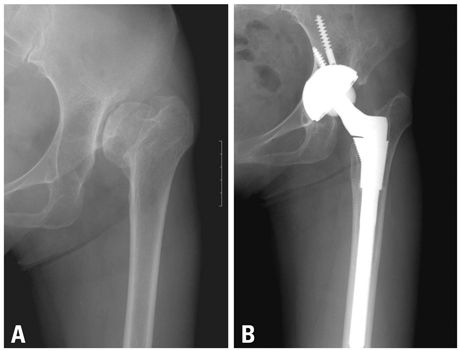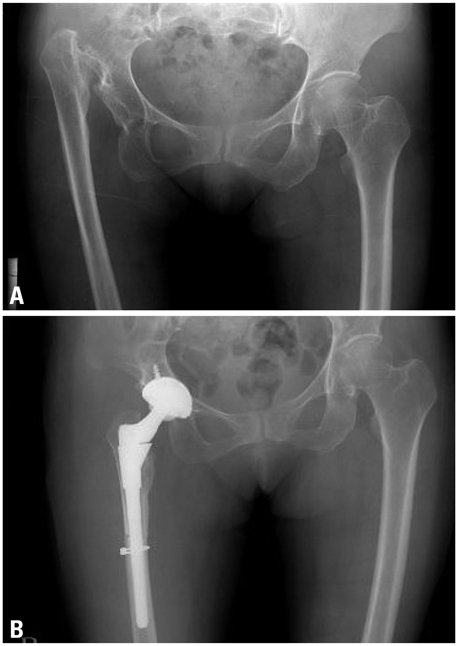Yonsei Med J.
2011 Jul;52(4):655-660. 10.3349/ymj.2011.52.4.655.
Total Hip Arthroplasty Using S-ROM Prosthesis for Dysplastic Hip
- Affiliations
-
- 1Department of Orthopaedic Surgery, Inha University College of Medicine, Incheon, Korea. kangjoon@inha.ac.kr
- KMID: 1727999
- DOI: http://doi.org/10.3349/ymj.2011.52.4.655
Abstract
- PURPOSE
The purpose of this study was to evaluate the clinical and radiological results of total hip arthroplasty using a proximal modular femoral stem in patients who had secondary coxarthrosis associated with a dysplastic hip.
MATERIALS AND METHODS
Forty-two patients (45 hips) with secondary coxarthrosis were evaluated after undergoing primary total hip arthroplasty using an S-ROM proximal modular femoral stem. The average follow-up was 80 months (range: 60 to 96 months). Clinical and radiological assessments were performed based on the Harris hip score and the radiological changes around the prosthesis.
RESULTS
The average Harris hip score improved from 52.2 points to 88.5 points. All femoral stems showed stable fixation; there were 37 cases by bony ingrowth and 8 cases by stable fibrous ingrowth. Neither osteolysis nor progressive radiolucent lines around the femoral stem were found at the last follow-up. Forty-one hips (91.9%) revealed excellent or good clinical results at the most recent follow-up.
CONCLUSION
For advanced secondary coxarthrosis, total hip arthroplasty with the use of the proximal modular femoral stem yielded good mid-term results with respect to the clinical and radiological criteria.
MeSH Terms
-
Adult
Aged
Arthroplasty, Replacement, Hip/adverse effects/*methods
Female
Femur/*pathology
Hip Dislocation, Congenital/complications/pathology/*surgery
*Hip Prosthesis
Humans
Joint Deformities, Acquired/complications/pathology/*surgery
Male
Middle Aged
Osteoarthritis, Hip/etiology/surgery
Postoperative Complications/pathology
Figure
Cited by 1 articles
-
Modular Stems: Advantages and Current Role in Primary Total Hip Arthroplasty
Chan-Woo Park, Seung-Jae Lim, Youn-Soo Park
Hip Pelvis. 2018;30(3):147-155. doi: 10.5371/hp.2018.30.3.147.
Reference
-
1. Aronson J. Osteoarthritis of the young adult hip: etiology and treatment. Instr Course Lect. 1986. 35:119–128.2. Cameron HU. Management of femoral deformities during the total hip replacement. Orthopedics. 1996. 19:745–746.
Article3. Gill TJ, Sledge JB, Müller ME. Total hip arthroplasty with use of an acetabular reinforcement ring in patients who have congenital dysplasia of the hip. Results at five to fifteen years. J Bone Joint Surg Am. 1998. 80:969–979.
Article4. Gorski JM. Modular noncemented total hip arthroplasty for congenital dislocation of the hip. Case report and design rationale. Clin Orthop Relat Res. 1988. 110–116.5. Crowe JF, Mani VJ, Ranawat CS. Total hip replacement in congenital dislocation and dysplasia of the hip. J Bone Joint Surg Am. 1979. 61:15–23.
Article6. Harris WH. Traumatic arthritis of the hip after dislocation and acetabular fractures: treatment by mold arthroplasty. An end-result study using a new method of result evaluation. J Bone Joint Surg Am. 1969. 51:737–755.
Article7. DeLee JG, Charnley J. Radiological demarcation of cemented sockets in total hip replacement. Clin Orthop Relat Res. 1976. 20–32.
Article8. Engh CA, Bobyn JD. The influence of stem size and extent of porous coating on femoral bone resorption after primary cementless hip arthroplasty. Clin Orthop Relat Res. 1988. (231):7–28.
Article9. Engh CA, Massin P, Suthers KE. Roentgenographic assessment of the biologic fixation of porous-surfaced femoral components. Clin Orthop Relat Res. 1990. 107–128.
Article10. Gruen TA. Lemons JE, editor. Radiographic criteria for the clinical performance of uncemented total joint replacements. Quantitative characterization and performance of porous implants for hard tissue applications. 1987. Philadelphia: American Society for Testing and Materials;207–218.
Article11. Brooker AF, Bowerman JW, Robinson RA, Riley LH Jr. Ectopic ossification following total hip replacement. Incidence and a method of classification. J Bone Joint Surg Am. 1973. 55:1629–1632.12. Kim YM, Lee SC, Kim HJ, Kim MH, Kang SB. A study on the shape of the proximal femur for designing Korean type of the femoral stem. J Korean Orthop Assoc. 1996. 31:949–961.
Article13. Lee TQ, Danto MI, Kim WC. Initial stability comparison of modular hip implants in synthetic femurs. Orthopedics. 1998. 21:885–888.
Article14. Cameron HU. Modularity in primary total hip arthroplasty. J Arthroplasty. 1996. 11:332–334.
Article15. Spitzer AI. The S-ROM cementless femoral stem: history and literature review. Orthopedics. 2005. 28:s1117–s1124.
Article16. Cameron HU. The 3-6-year results of a modular noncemented low-bending stiffness hip implant. A preliminary study. J Arthroplasty. 1993. 8:239–243.
Article17. Park YS, Han GY, Kim SJ. Primary total hip arthroplasty using S-ROM(R) modular femoral stem: minimum 5 years follow up results. J Korean Hip Soc. 2000. 12:315–321.18. Park YS, Yi SR, Moon SH. Total hip arthroplasty using the S-ROM modular femoral stem: preliminary report of cases with at least a 2 year follow-up. J Korean Hip Soc. 1997. 9:99–104.19. Cameron HU, Keppler L, McTighe T. The role of modularity in primary total hip arthroplasty. J Arthroplasty. 2006. 21:89–92.
Article20. Cameron HU, Botsford DJ, Park YS. Influence of the Crowe rating on the outcome of total hip arthroplasty in congenital hip dysplasia. J Arthroplasty. 1996. 11:582–587.
Article21. Rosenthall L, Bobyn JD, Brooks CE. Temporal changes of periprosthetic bone density in patients with a modular noncemented femoral prosthesis. J Arthroplasty. 1999. 14:71–76.
Article22. Tanzer M, Chan S, Brooks CE, Bobyn JD. Primary cementless total hip arthroplasty using a modular femoral component: a minimum 6-year follow-up. J Arthroplasty. 2001. 16:64–70.
Article23. Cook SD, Manley MT, Kester MA, Dong NG. Torsional resistance and wear of a modular sleeve-stem hip system. Clin Mater. 1993. 12:153–158.
Article24. Chmell MJ, Rispler D, Poss R. The impact of modularity in total hip arthroplasty. Clin Orthop Relat Res. 1995. 77–84.
Article25. Urban RM, Jacobs JJ, Gilbert JL, Galante JO. Migration of corrosion products from modular hip prostheses. Particle microanalysis and histopathological findings. J Bone Joint Surg Am. 1994. 76:1345–1359.
Article26. Krygier JJ, Dujovne AR, Bobyn JD. Fatigue behavior of titanium femoral hip prosthesis with proximal sleeve-stem modularity. J Appl Biomater. 1994. 5:195–201.
Article27. Chandler HP, Ayres DK, Tan RC, Anderson LC, Varma AK. Revision total hip replacement using the S-ROM femoral component. Clin Orthop Relat Res. 1995. 130–140.
Article



